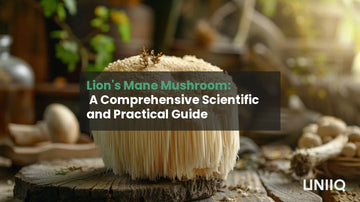Introduction: The Rising Interest in Lion’s Mane
Lion’s Mane mushroom (Hericium erinaceus) is a striking white fungus with cascading spines that give it the appearance of a lion’s mane. Beyond its unique look, it has a long history of culinary and medicinal use in East Asia. Recent scientific research is uncovering its bioactive compounds and exploring their potential to support human health, particularly in areas such as cognition, immunity, and gut health.

1. Botanical and Taxonomic Overview
1.1 Classification
Lion’s Mane belongs to the Hericiaceae family in the Basidiomycota phylum. It is a saprotrophic fungus, typically found on decaying hardwoods in temperate forests.

1.2 Global Distribution
Native to North America, Europe, and Asia, Lion’s Mane thrives in temperate climates and is increasingly cultivated commercially for both culinary and supplement use.
2. Traditional Uses and Historical Context
2.1 Use in East Asian Medicine
For centuries, Lion’s Mane has been consumed in China and Japan, traditionally believed to support general well-being and digestive health.

2.2 Modern Culinary Value
Its texture is often compared to seafood such as crab or lobster, making it a sought-after ingredient in vegetarian and gourmet cooking.
3. Bioactive Compounds in Lion’s Mane
3.1 Beta-glucans
Beta-glucans are polysaccharides known for their ability to modulate immune responses (NIH Fact Sheet). In Lion’s Mane, they contribute to its immune-related properties.
3.2 Erinacines and Hericenones
Erinacines (mycelium-derived) and hericenones (fruiting body-derived) have been shown in laboratory studies to promote nerve growth factor (NGF) synthesis (NCBI).

4. Potential Cognitive Benefits
4.1 NGF and Neurogenesis
NGF is essential for the maintenance and regeneration of certain types of neurons. Laboratory and animal studies show that Lion’s Mane extracts can stimulate NGF production, potentially supporting brain plasticity.
4.2 Human Cognitive Trials
A double-blind, placebo-controlled study in older adults with mild cognitive impairment found that daily supplementation with Lion’s Mane improved cognitive scores over 16 weeks (Mori et al., 2009).

4.3 Focus and Mental Clarity
While large-scale trials are limited, preliminary research and anecdotal reports suggest possible benefits for concentration and mental performance.
Looking to buy Lion's Mane? We have EU compliant Lion's Mane with the best bio availability and potency on the market. Check it out.
5. Immune and Anti-inflammatory Properties
5.1 Immune Modulation
Lion’s Mane beta-glucans may stimulate immune cells such as macrophages and natural killer cells (NCBI Immunology Review).
5.2 Anti-inflammatory Effects
Animal studies have shown reduced pro-inflammatory cytokines like TNF-α and IL-6 following Lion’s Mane supplementation (Journal of Agricultural and Food Chemistry).

6. Digestive and Gut Health Support
6.1 Prebiotic Potential
Lion’s Mane polysaccharides may act as prebiotics, promoting beneficial gut bacteria growth (NCBI Gut Microbiota Study).
6.2 Gastric Protection
Rodent studies suggest Lion’s Mane extracts may reduce ulcer formation by enhancing gastric mucosal defence (PubMed Study).

7. Additional Areas of Research
7.1 Mood and Mental Well-being
A small clinical trial in women found that Lion’s Mane cookies reduced symptoms of anxiety and depression (Nagano et al., 2010).
7.2 Antioxidant Properties
Extracts have demonstrated significant antioxidant activity in vitro, which may contribute to reduced oxidative stress.
7.3 Cardiometabolic Impact
Preliminary research suggests potential cholesterol-lowering effects, though human trials are scarce.

8. Consumption Forms
8.1 Fresh and Culinary Uses
Fresh Lion’s Mane can be sautéed, roasted, or used in soups, retaining both its texture and mild flavour.
8.2 Supplement Formats
Available as powders, capsules, or tinctures, with concentrations varying based on extraction method.
9. Choosing a High-quality Lion’s Mane Supplement
9.1 Fruiting Body vs. Mycelium
The fruiting body contains more hericenones, while mycelium is richer in erinacines — both have distinct bioactive profiles.
9.2 Extraction Methods
Hot water and dual extraction methods ensure both polysaccharides and terpenoids are retained (USP Extraction Standards).
9.3 Uniiq’s Quality Commitment
At Uniiq, our Lion’s Mane products are made exclusively from the fruiting body, dual-extracted for maximum bioactive content, and tested for purity and potency.

10. Safety Profile and Precautions
10.1 General Safety
Lion’s Mane is generally well tolerated when consumed as part of the diet or in standardised supplements.
10.2 Allergic Reactions
Rare allergic skin reactions have been reported — individuals with mushroom allergies should exercise caution.
Conclusion
Lion’s Mane (Hericium erinaceus) combines culinary appeal with a growing body of scientific evidence suggesting potential benefits for cognition, immunity, gut health, and more. While ongoing research will clarify its mechanisms and applications, it is already a valued functional food and supplement choice.
Uniiq’s carefully sourced, dual-extracted Lion’s Mane is designed to deliver the mushroom’s most studied compounds in a high-quality format, supporting those who wish to incorporate this remarkable fungus into their daily routines.








